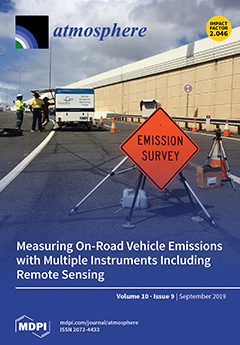During the Japanese intercomparison study, Japan’s Study for Reference Air Quality Modeling (J-STREAM), it was found that wintertime SO
42– concentrations were underestimated over Japan with the Community Multiscale Air Quality (CMAQ) modeling system. Previously, following two development phases, model performance was
[...] Read more.
During the Japanese intercomparison study, Japan’s Study for Reference Air Quality Modeling (J-STREAM), it was found that wintertime SO
42– concentrations were underestimated over Japan with the Community Multiscale Air Quality (CMAQ) modeling system. Previously, following two development phases, model performance was improved by refining the Fe- and Mn-catalyzed oxidation pathways and by including an additional aqueous-phase pathway via NO
2 oxidation. In a third phase, we examined a winter haze period in December 2016, involving a gas-phase oxidation pathway whereby three stabilized Criegee intermediates (SCI) were incorporated into the model. We also included options for a kinetic mass transfer aqueous-phase calculation. According to statistical analysis, simulations compared well with hourly SO
42– observations in Tokyo. Source sensitivities for four domestic emission sources (transportation, stationary combustion, fugitive VOC, and agricultural NH
3) were investigated. During the haze period, contributions from other sources (overseas and volcanic emissions) dominated, while domestic sources, including transportation and fuel combustion, played a role in enhancing SO
42– concentrations around Tokyo Bay. Updating the aqueous phase metal catalyzed and NO
2 oxidation pathways lead to increase contribution from other sources, and the additional gas phase SCI chemistry provided a link between fugitive VOC emission and SO
42– concentration via changes in O
3 concentration.
Full article


